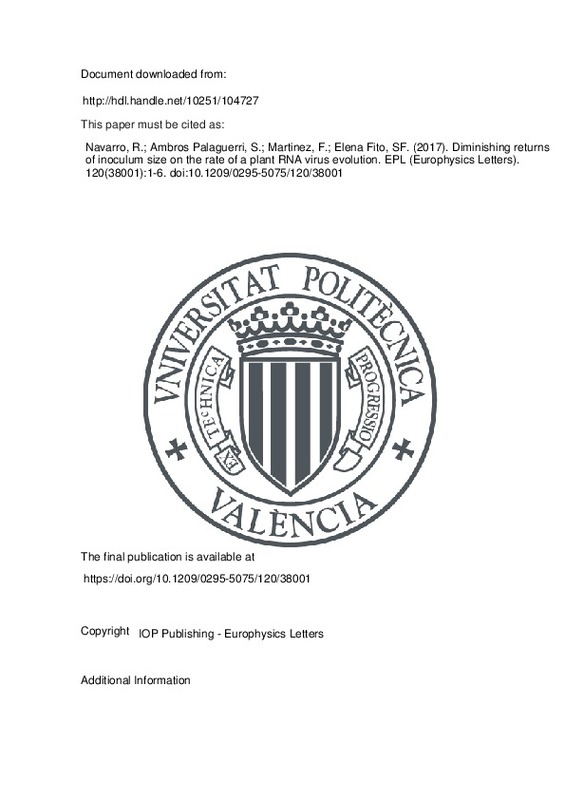JavaScript is disabled for your browser. Some features of this site may not work without it.
Buscar en RiuNet
Listar
Mi cuenta
Estadísticas
Ayuda RiuNet
Admin. UPV
Diminishing returns of inoculum size on the rate of a plant RNA virus evolution
Mostrar el registro sencillo del ítem
Ficheros en el ítem
| dc.contributor.author | Navarro, Rebeca
|
es_ES |
| dc.contributor.author | Ambros Palaguerri, Silvia
|
es_ES |
| dc.contributor.author | Martinez, Fernando
|
es_ES |
| dc.contributor.author | Elena Fito, Santiago Fco.
|
es_ES |
| dc.date.accessioned | 2018-06-28T04:24:35Z | |
| dc.date.available | 2018-06-28T04:24:35Z | |
| dc.date.issued | 2017 | es_ES |
| dc.identifier.issn | 0295-5075 | es_ES |
| dc.identifier.uri | http://hdl.handle.net/10251/104727 | |
| dc.description.abstract | [EN] Understanding how genetic drift, mutation and selection interplay in determining the evolutionary fate of populations is one of the central themes of Evolutionary Biology. Theory predicts that by increasing the number of coexisting beneficial alleles in a population beyond some point does not necessarily translates into an acceleration in the rate of evolution. This diminishing-returns effect of beneficial genetic variability in microbial asexual populations is known as clonal interference. Clonal interference has been shown to operate in experimental populations of animal RNA viruses replicating in cell cultures. Here we carried out experiments to test whether a similar diminishing-returns of population size on the rate of adaptation exists for a plant RNA virus infecting real multicellular hosts. We have performed evolution experiments with tobacco etch potyvirus in two hosts, the natural and a novel one, at different inoculation sizes and estimated the rates of evolution for two phenotypic fitness-related traits. Firstly, we found that evolution proceeds faster in the novel than in the original host. Secondly, results were compatible with a diminishing-returns effect of inoculum size on the rate of evolution for one of the fitness traits, but not for the other, which suggests that selection operates differently on each trait. | es_ES |
| dc.description.sponsorship | We thank F. DE LA IGLESIA and P. AGUDO for excellent technical support and J. A. CUESTA for critical reading and insightful suggestions. This work was supported by grant BFU2015-65037-P from Spain's Ministry of Economy, Industry and Competitiveness and by the Santa Fe Institute. | en_EN |
| dc.language | Inglés | es_ES |
| dc.publisher | IOP Publishing - Europhysics Letters | es_ES |
| dc.relation.ispartof | EPL (Europhysics Letters) | es_ES |
| dc.rights | Reserva de todos los derechos | es_ES |
| dc.title | Diminishing returns of inoculum size on the rate of a plant RNA virus evolution | es_ES |
| dc.type | Artículo | es_ES |
| dc.identifier.doi | 10.1209/0295-5075/120/38001 | es_ES |
| dc.relation.projectID | info:eu-repo/grantAgreement/MINECO//BFU2015-65037-P/ES/EVOLUCION DE VIRUS EN HUESPEDES CON SUSCEPTIBILIDAD VARIABLE: CONSECUENCIAS EN EFICACIA Y VIRULENCIA DE CAMBIOS EN LAS REDES INTERACTOMICAS DE PROTEINAS VIRUS-HUESPED/ | es_ES |
| dc.rights.accessRights | Abierto | es_ES |
| dc.date.embargoEndDate | 2018-12-01 | es_ES |
| dc.contributor.affiliation | Universitat Politècnica de València. Instituto Universitario Mixto de Biología Molecular y Celular de Plantas - Institut Universitari Mixt de Biologia Molecular i Cel·lular de Plantes | es_ES |
| dc.description.bibliographicCitation | Navarro, R.; Ambros Palaguerri, S.; Martinez, F.; Elena Fito, SF. (2017). Diminishing returns of inoculum size on the rate of a plant RNA virus evolution. EPL (Europhysics Letters). 120(38001):1-6. https://doi.org/10.1209/0295-5075/120/38001 | es_ES |
| dc.description.accrualMethod | S | es_ES |
| dc.relation.publisherversion | https://doi.org/10.1209/0295-5075/120/38001 | es_ES |
| dc.description.upvformatpinicio | 1 | es_ES |
| dc.description.upvformatpfin | 6 | es_ES |
| dc.type.version | info:eu-repo/semantics/publishedVersion | es_ES |
| dc.description.volume | 120 | es_ES |
| dc.description.issue | 38001 | es_ES |
| dc.relation.pasarela | S\357618 | es_ES |
| dc.contributor.funder | Ministerio de Economía, Industria y Competitividad | es_ES |







![[Cerrado]](/themes/UPV/images/candado.png)

